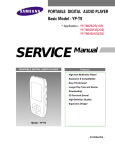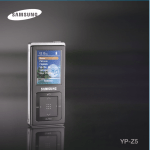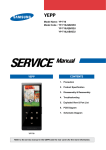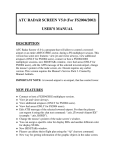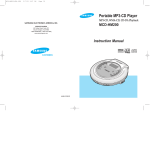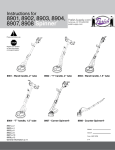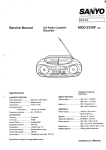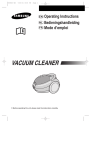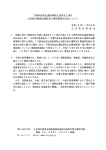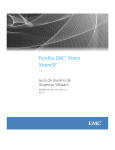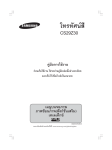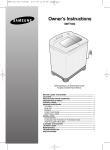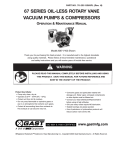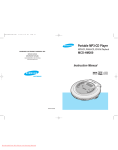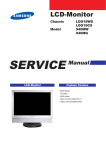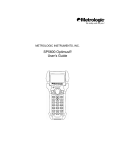Download Samsung YP-F2JX Service manual
Transcript
PORTABLE DIGITAL AUDIO PLAYER
Basic Model : YP-Z5F
* Application : YP-Z5F ZB/ZS/ZW/ZP [1GB]
YP-Z5F QB/QS/QW/QP [2GB]
YP-Z5F AB/AS/AW/AP [4GB]
SERVICE
Manual
PORTABLE DIGITAL AUDIO PLAYER
Features
- MP3,WMA,Secure WMA Playback
- MTP Device
- Image Viewer
- Color TFT LCD
- DNSe Surround Sound
- USB 2.0 High Speed Data Transfer
- Built-in Rechargeable Li-polymer
Battery
- Beep on/off
- Upgradable Firmware
- FM Tuner
Model : YP-Z5F
- Confidential -
ELECTRONICS
© Samsung Electronics Co.,Ltd. MAR. 2006
Printed in Korea
Code no. AH68-01819G
INDEX
Ch1
Ch7
Precautions
1-1. Safety Precautions
1-2. Servicing Precautions
1-3. Precautions for Electrostatically
Sensitive Device (ESDs)
1-4. Special Precations and Waring
Lables for Laser Products
1-5. Special Precautions for HDD
1-1
1-2
1-3
Exploded View & Parts List
1. Total Exploded View
2. Parts List
Ch8
Electrical Parts List
Electrical Parts List
1-4
1-5
Ch9
2-1
2-2
2-3
3-1
2. New Functions
3-5
3. PC Connections
3-9
Adjustments
4-1
2. How to upgrade Firmware
4-2
How to disassemble
How to disassemble
Ch6
5-1
Troubleshooting
1.Power failure
2. No audio sounds
3. Touchpad
4. Button
6-1
6-2
6-3
6-4
Wiring Diagram
Wiring Diagram
10-1
PCB Diagram
1. TOP
11-1
2. BOTTOM
11-2
Ch12
1. How to reset the system
Ch5
Ch10
Ch11
Product Functions
1. Basic Functions
Ch4
9-1
Product Descriptions
1. Product Feature
2. Specifications
3. Accessories
Ch3
8-1
Block Diagram
Block Diagram
Ch2
7-1
7-2
Schematic Diagram
1. MAIN
12-1
2. SELF-TEST Manual
12-2
Ch13
Circuit Description
1. Circuit Board Description
13-1
2. Main Functions by Block
13-2
Ch14
Basic Information of MP3
1. Operating Principle of yepp
14-1
2. MP3 Overview
14-5
3. Understanding of Digital Audio Format
14-6
4. Type of Storage
14-9
5. Copyright
14-11
1. Precautions
Follow these safety, servicing and ESD precautions to prevent damage and protect against potential hazards such as electrical shock and X-rays.
1-1 Safety Precautions
1. Be sure that all of the built-in protective
devices are replaced.
2. When reinstalling the chassis and its
assemblies, be sure to restore all protective
devices, including control knobs and
compartment covers.
3. Make sure that there are no cabinet
openings through which people-particularly children--might insert fingers
and contact dangerous voltages. Such
openings include the spacing between the
picture tube and the cabinet mask,
excessively wide cabinet ventilation slots,
and improperly fitted back covers.
4. Design Alteration Warning:
Never alter or add to the mechanical or
electrical design of the unit. Example: Do
not add auxiliary audio or video connectors.
Such alterations might create a safety hazard. Also, any design changes or additions
will void the manufacturer's warranty.
5. Leakage Current Hot Check (Figure 1-1):
Warning: Do not use an isolation
transformer during this test. Use a leakage-current tester or a metering system
that complies with American National
Standards Institute (ANSI C101.1, Leakage
Current for Appliances), and Underwriters
Laboratories (UL Publication UL1410,
59.7).
With the unit completely reassembled, plug
the AC line cord directly into a 120V AC
outlet. With the unit's AC switch first in the
ON position and then OFF, measure the
current between a known earth ground
(metal water pipe, etc.) and all exposed
metal parts. Examples: Handle brackets,
metal cabinets, screwheads and control
shafts. The current measured should not
exceed 0.5 milliamp. Reverse the powerplug prongs in the AC outlet and repeat.
(Reading should
not be above
0.5mA)
Device
Under
Test
Leakage
Currant
Tester
Test all
exposed metal
surfaces
2-Wire Cord
Also test with
plug reversed
(using AC adapter
plug as required)
Earth
Ground
Fig. 1-1 AC Leakage Test
6. Insulation Resistance Cold Check:
(1) With the unit's AC plug disconnected
from the AC source, connect an electrical
jumper across the two AC prongs. (2) Set
the power switch to ON. (3) Measure the
resistance between the shorted AC plug and
any exposed metallic parts. Example:
Screwheads, antenna, control shafts or
handle brackets.
If any of the exposed metallic parts has a
return path to the chassis, the measured
resistance should be between 1 and 5.2
megohms. If there is no return path, the
measured resistance should be "infinite." If
the resistance is outside these limits, a
shock hazard might exist. See Figure 1-2
Antenna
Terminal
Exposed
Metal Part
ohm
Ohmmeter
Fig. 1-2 Insulation Resistance Test
1-1
Samsung Electronics
Precautions
1-1 Safety Precautions (Continued)
7. Components, parts and wiring that appear
to have overheated or that are otherwise
damaged should be replaced with parts
that meet the original specifications.
Always determine the cause of damage or
overheating, and correct any potential
hazards
8. Observe the original lead dress, especially
near the following areas: Antenna
wiring, sharp edges, and especially the
AC and high voltage power supplies.
Always inspect for pinched, out-of-place,
or frayed wiring. Do not change the
spacing between components and the
printed circuit board. Check the AC
power cord for damage. Make sure that
no wires or components touch thermally
hot parts.
9. Product Safety Notice:
Some electrical and mechanical parts
have special safety-related characteristics
which might not be obvious from visual
inspection. These safety features and the
protection they give might be lost if the
replacement component differs from the
original--even if the replacement is rated
for higher voltage, wattage, etc.
10 Components that are critical for safety are
indicated in the circuit diagram by
shading,
or
. Use replacement
components that have the same ratings,
especially for flame resistance and
dielectric strength specifications. A
replacement part that does not have the
same safety characteristics as the original
might create shock, fire or other hazards.
1-2 Servicing Precautions
Warning1: First read the "Safety Precautions" section of this manual. If some unforeseen circumstance
creates a conflict between the servicing and safety precautions, always follow the safety precautions.
1. Servicing precautions are printed on the
cabinet. Follow them.
2. Always unplug the unit's AC power cord from
the AC power source before
attempting to: (a) Remove or reinstall any
component or assembly, (b) Disconnect an
electrical plug or connector, (c) Connect a
test component in parallel with an
electrolytic capacitor.
3. Some components are raised above the
printed circuit board for safety. An
insulation tube or tape is sometimes used.
The internal wiring may be clamped to
prevent contact with thermally hot
components. Reinstall all such elements to
their original position.
4. After servicing, always check that the
screws, components and wiring have been
correctly reinstalled. Make sure that the
portion around the serviced part has not
been damaged.
Samsung Electronics
5. Check the insulation between the blades of
the AC plug and accessible conductive parts
(examples: metal panels, input terminals
and earphone jacks).
6. Insulation Checking Procedure: Disconnect
the power cord from the AC source and
turn the power switch ON. Connect an
insulation resistance meter (500V) to the
blades of the AC plug.
The insulation resistance between each
blade of the AC plug and accessible
conductive parts (see above) should be
greater than 1 megohm.
7. Never defeat any of the B+ voltage
interlocks. Do not apply AC power to the
unit (or any of its assemblies) unless all
solid-state heat sinks are correctly installed.
8. Always connect a test instrument's ground
lead to the instrument chassis ground
before connecting the positive lead; always
remove the instrument's ground lead last.
1-2
Precautions
1-3 Precautions for Electrostatically Sensitive Devices (ESDs)
5. Use only a grounded-tip soldering iron
when soldering or unsoldering ESDs.
1. Some semiconductor ("solid state") devices
are easily damaged by static electricity.
Such components are called Electrostatically
Sensitive Devices (ESDs). Examples
include integrated circuits and some fieldeffect
transistors. The following techniques will
reduce the occurrence of component
damage caused by static electricity.
6. Use only an anti-static solder removal
device. Many solder removal devices are
not rated as "anti-static" (these can
accumulate sufficient electrical charge to
damage ESDs).
7. Do not remove a replacement ESD from its
protective package until you are ready to
install it. Most replacement ESDs are
packaged with leads that are electrically
shorted together by conductive foam,
aluminum foil or other conductive
materials.
2. Immediately before handling any
semiconductor components or assemblies,
drain the electrostatic charge from your
body by touching a known earth ground.
Alternatively, wear a discharging
wrist-strap device. (Be sure to remove it
prior to applying power--this is an electric
shock precaution.)
8. Immediately before removing the protective
material from the leads of a replacement
ESD, touch the protective material to the
chassis or circuit assembly into which the
device will be installed.
3. After removing an ESD-equipped assembly,
place it on a conductive surface such as
aluminum foil to prevent accumulation of
electrostatic charge.
9. Minimize body motions when handing
unpackaged replacement ESDs. Motions
such as brushing clothes together, or lifting
a foot from a carpeted floor can generate
enough static electricity to damage an ESD.
4. Do not use freon-propelled chemicals.
These can generate electrical charges that
damage ESDs.
1-4 Special Precautions and Warning Labels for Laser Products
(UL)
(CSA)
This Product Complies with
DHHS Rules 21CFR, Sub
chapter J.At date of Manufacture
(UL,CSA,EU)
CERTIFIED ONLY TO CANADIAN
ELECTRICAL CODE.
CLASS 1
LASER PRODUCT
CERTIFIE EN VERTU DU CODE
CANADIAN DE LELETRICITE
SEULEMENT
Fig. 1-3 Warning Labels (Location: Enclosure Block)
(UL,CSA,SCAN)
CAUTION : INVISIBLE LASER RADIATION WHEN OPEN
AND INTERLOCKS DEFEATEO AVOIDEXPOSURE TO BEAM
ADVARSEL: USYNLIG LASERSTRÅLING VED ABNING
NÅR SIKKERHEDSAFBRYDERE ER UDE AF FUNKTION
UNDGA UDSAETTELSE FOR STRALING
VARO:AVATTAESSA JA SUOJALUKITUS OHITETTAESSA
OLET ALTTINA NAKYMATTÖMALLE LASERSATEILYLLE ALA
KATSO SATEESEEN!
VARNING:OSYNLIG LASERSTRÅLNING NAR DENNA DEL
(EU)
UL
CSA
EU
SCAN
: Manufactured for U.S.A. Market.
: Manufactured for Canadian Market.
: Manufactured for European Market.
: Manufactured for Scandinavian
Market.
AR OPPNAD OCH SPARREN AR URKOPPLAD BETRAKTA
EJSTRÅLEN!
Fig. 1-4 Warning Labels (Location: Disc Clamper, Inner Side of Unit Door or Nearby Unit Chassis )
1-3
Samsung Electronics
Precautions
1-4 Special Precautions and Warning Labels for Laser Products (Continued)
1-4-1 Warnings
1. When servicing, do not approach the
LASER exit with the eye too closely. In
case it is
necessary to confirm LASER beam emission, be sure to observe from a distance of
more than 30 cm from the surface of the
objective lens on the optical pick-up block.
2. Do not attempt to handle the objective lens
when the DISC is not on the tray.
1-4-2 Laser Diode Specifications
Material: GaAs+ GaAlAs
Wavelength: 760-800 nm
Emission Duration: Continuous
1-4-3 Handling the Optical Pick-up
1. Static electricity from clothing or the body
may cause electrostatic breakdown of the
laser diode in the Optical Pickup. Follow
this procedure:
2. Place a conductive sheet on the work bench
(i.e., the black sheet used for wrapping
repair parts.) Note: The surface of the work
bench should be covered by a copper
ground plane, which is grounded.
3. The repair technician must wear a wrist
strap which is grounded to the copper
sheet.
4. To remove the Optical Pickup block:
Place the set on the conductive sheet, and
momentarily touch the conductive sheet
with both hands. (While working, do not
allow any electrostatic sources--such as
clothes--to touch the unit.)
Laser Output: 0.2 mw (measured at a
1.6 mm distance from the objective lens
surface on the optical pick-up block.)
5. Ground the "Short Terminal" (located on the
PCB, inside the Pickup Assembly) before
replacing the Pickup. This terminal should
be shorted whenever the Pickup Assembly
is lifted or moved.
short
terminal
SOH91VI(LDP)
short terminal
SOH91CI(CAR,walkman)
6. After replacing the Pickup, reopen the Short
See diagrams below:
1M
THE UNIT
(1) WRIST-STRAP
FOR GROUNDING
short
terminal
SOH-A1
(CMS-V10,CMS-V30)
CONDUCTIVE SHEET
1M
short
terminal
SOH94T4N
(CMS-V10,CMS-V30)
1-5 Special Precautions for HDD
* HDD Data Maintenance Step
1. Since the data on the HDD is weak to mechanical shock, place the HDD in a safe
location that is free from mechanical shock once it is removed from the main unit.
2. In order to safe keep the data on the HDD, back up the data before the repair or
make sure not to place the HDD near any electrical appliance that generates a
strong magnetic field.
Samsung Electronics
1-4
2. Product Descriptions
1. Product Feature
Concept
Specifications
Samsung Electronics
Premium Stylish Slim Design Flash Jukebox Playing
Reminiscence
1. Memory Capacity : 2GB, 4GB
2. LCD : 1.82" 65,000 Colors
3. Play Time : 38 Hours
4. Slim Size : 11.4mm Thickness
5. SNR : 92dB
6. Supported File Formats
: MP3, WMA, Secure WMP
7. Supported lmage Formats : JPEG
8. Battery Capacity : 820mAh
9. Interface : Windows XP USB 2.0
10. MTP Mode Dedicated Device
2-1
2. Specifications
Model Name
YP-Z5
Power
-
Built-in Battery Power
mAh
File
Compatibility
-
Earphone Output
mW
Output Frequency Range
-
Noise Ratio
dB
Play Time
-
3.7V (Li-Polymer Rechargeable)
820mAh
AUDIO: MPEG1/2/2.5 Layer3(8kbps~320kbps, 8kHz~48kHz), MPEG1
Layer2(32kbps~384kbps, 32kHz, 44.1kHz, 48kHz),
WMA(8kbps~192kbps,8kHz~44.1kHz)
IMAGE: JPEG(ISO/IEC 10918-1/Annex F-Sequential DCT-based
mode of operation)
22 (16Ω)
20Hz~20KHz
92 with 20kHz LPF(based on 1KHz 0 dB)
35 hours of music play
File Transmission Speed Mbps
Max 40
Temperature Range for
Operation
°C
5~35 (23~95°F)
Case
-
Aluminum
Weight
oz
1.98 (inc. battery)
Dimension
(WxHxD)
inches
2GB : 1.66 X 3.54 X 0.45
4GB : 1.66 X 3.54 X 0.48
● The contents of this Manual are subject to change without prior notice for further
improvement.
2-2
Samsung Electronics
» …”
3. Accessories (options)
Accessories
Name
Code No.
AH30-00086D
(WHITE)
Earphone
USB cable
» …”
AH30-00087D
(BLACK)
AH39-00783B
2-3
3. Product Functions
1. Basic Functions
Checking the
Accessories
Player
n
Earphones
USB Cable
Easy Start CD
Design of accessories is subject to change for the purpose of improvement, without notice.
Screen Display
Information
Browse
1 Current Time Display
2 Album Title Display
3 Album Display
8 Play/Pause/Stop Display
9 Music Title Display
10 Street Mode Display
4 3D Sound Displays
11 Repeat Play Display
5 File Type Display
12 Total Play Time Display
13 Current Music Number/
(MP3, WMA etc)
0:30
13
6 Play Status Bar
Total Number Display
7 Play Time Display
Components
Earphone Connection Port
Neck String Hole
Lock Switch
Screen Display
Volume Control Button
Power/USB Connection Port
Back Button
Move Track/Quick Search Button
Reset Button
Touch Pad/Select Button
Power & Play/Pause Button
3-1
Samsung Electronics
Button Functions
Buttons
Basic Use
Functions and Use
n
n
n
n
n
n
Turning the Power On & Off
Long press for power off
Short press for power on & Play/Pause
Turning the Power On Press the
Artists
Albums
Genres
Composers
Playlists
Shuffle
All Songs
Long press to move to the Menu screen
Short press to move to the previous screen
Long press to scan to a point on the current track.
Short press to move to the previous track or to play the current track from the start
[
n
] button.
To turn the Power On.
Turning the Power Off
Press and hold the [
n
n
n
n
Long press to scan to a point on the current track.
Short press to move to the next track
n
n
Push in the direction of the arrow to lock the button functions
] button
Power is turned off.
Power is automatically turned off when none of the
buttons have been pressed for a preset period of time
(Default: 1 minute) in the pause mode.
Press with a pointed object to reset.
Playing Music
Buttons
Functions and Use
n
Moving up, down, left and right and Function Selection
02:21 PM
Tap on the top or bottom side to move up or down by one selection.
Tap on the left or right side to move left or right by
one selection (Picture mode).
1
2
Touch lightly and slide up or down to move up or downward.
Touch lightly and slide left or right to move to the
left or right (Picture mode).
Press and hold the [
the Menu screen.
Touch the [Touch Pad] and slide up to select
<Music>, then press the [Touch Pad].
n
3
0:30
Touch lightly and slide up, down, left or right while a
photo is magnified to move to your desired position.
4
Press the center of the Touchpad to select the function
and move to the next screen.
] button to move to
The Music Menu will appear.
Touch the [Touch Pad] and slide up or down to
select a music file of your choice.
Touch the Touchpad and the Music file will
begin playing.
NOTE
CAUTION
- Do not use any sharp object other than your fingers to operate the touchpad. Otherwise,
touchpad may be damaged.
n
n
Press the [
] button to move to the previous screen.
Press and hold the [
] button to move to the Menu screen.
Volume Control
Charging the battery
Fully charge the battery before using the player for the first time or when the it has not
been used for a while.
Browse
1 Connect the USB cable to the USB
2
Screen Display
°·
Recharging
°·
(Green) Recharge
Complete
port (
n
n
) on your PC.
2 Connect the other end of the USB cable
Press the [ + , - ] button on the side of the
unit.
The Volume Status Bar will appear.
Press the + button to increase the volume or
the – button to decrease it.
0:30
to the Power/USB Connection Port on
bottom of the player.
ßô <CONNECTED> appears on the screen dis-
play of the player.
ßô When connected with the USB cable, it takes
about 4 hours for a full charge although this may
Lock Function
vary depending on the PC environment.
1
Battery Use
Samsung Electronics
n
Recharge and store within the temperature range of
5°C~35°C(40°F~95°F).
n
Do not overcharge (longer than 12 hours). Excessive
charging or discharging may shorten the battery’s life.
n
Battery life naturally shortens slowly over time as it is
a consumable item.
Browse
1
2
0:30
Push the [HOLD] button on the top of the
unit in the direction of the arrow.
Push the [HOLD] button in the opposite
direction of the arrow to release the Lock
function.
3-2
Reset Function
If a product malfunction occurs, you
can re-initialize the system by
pressing the Reset button.
Reset Button
PC Requirements
For use in conjunction with a PC, the following is required:
n
n
n
n
n
n
n
3-3
Pentium 300MHz or higher
Windows XP Service Pack 1 or higher
100MB of free hard disc space
CD Rom Drive (2X or higher)
USB Port 2.0 only
DirectX 9.0 or higher
Windows Media Player 10.0 or higher
Samsung Electronics
2. New Functions
Shuffle Play All Music
2:10
1 Press and hold the [
AM
Music
Pictures
Playlists
Shuffle All
Settings
Now Playing
] button
to move to the Menu screen.
the [Touch Pad] and slide up or down to select
2 Touch
<Shuffle All>, then press the [Touch Pad].
■
Rising Sun
Music files will appear.
the [Touch Pad] and slide up or down to select a
3 Touch
music file to play, then press the [Touch Pad].
■
The file selected, then all music files contained on the player will
start playing in random order.
Shuffle Play by Type
E.g. Shuffle Play by Artist
1 Press and hold the [ ] button to move to the Menu screen.
the [Touch Pad] and slide up or down to select
2 Touch
<Music>, then press the [Touch Pad].
Shuffle
Artists
Albums
Genres
Composers
Playlists
All Songs
■
The Music Menu will appear.
the [Touch Pad] and slide up or down to select
3 Touch
<Shuffle>, then press the [Touch Pad].
Rising Sun
■
The Shuffle Menu will appear.
Shuffle Menu
<Artists> : To play by artist
<Albums> : To play by album
<Genres> : To play by genre
<Composers> : To play by
composer
<Playlists> : To play by Playlist
<Shuffle> : To play continuously
at random
<All Songs> : To play in
numeric or alphabetical order
■
■
■
■
■
■
■
the [Touch Pad] and slide up or down to select
4 Touch
<Artists>, then press the [Touch Pad].
■
Artist list will appear.
the [Touch Pad] and slide up or down to select an
5 Touch
artist, then press the [Touch Pad].
■
The music files for the selected artist will appear in random order.
the [Touch Pad] and slide up or down to select
6 Touch
a music file to play, then press the [Touch Pad].
■
The music files under that particular <Artist> will start playing
continuously in random order.
Checking the Music Information
2:10
1 Press and hold the [
AM
Samsung MP3
] button to move to the Menu screen.
Samsung
the [Touch Pad] and slide up or down to select
2 Touch
<Now Playing>, then press the [Touch Pad].
MP3
0:49
DNSe
2/2
STR
REP
1:36
■
The music information screen for the track currently playing will
appear.
Rising Sun
3-4
Samsung Electronics
Picture Viewing
Picture Viewing
2:10
and hold the [
1 Press
Menu screen.
] button to move to the
AM
the [Touch Pad] and slide up or down to
2 Touch
select <Pictures>, then press the [Touch Pad].
The Picture Folder list will appear.
Touch the [Touch Pad] and slide up or down to
select a folder, then press the [Touch Pad] to
display the pictures.
■
Touch the [Touch Pad] and slide up or down
the picture file of your choice,
1 3 tothenselect
press the [Touch Pad].
2,3
■
NOTE
■
■
The selected file will appear.
■
Large pictures may take longer to display.
Press the [ lœœ√√l ] button while viewing a picture to display the previous or next picture.
Press and hold the [Touch Pad] button while viewing a picture to make it the background of the player.
Photo Viewing
Picture Enlarging/Slideshow Viewing
Picture Enlarging
2:10
the [Touch Pad] in the Picture Viewing
1 Press
mode.
AM
■
The picture will be gradually enlarged each time the
[Touch Pad] is pressed.
the [Touch Pad] and slide up or down to
2 Touch
move around the enlarged picture.
■
You can move to the area of your choice.
Press the [
] button to cancel the
2 ,3 3 enlargement.
■
1,2
The picture will be gradually downsized each time the
[ ] button is pressed.
Slideshow Viewing
Press the [
] button in Picture List or
1 1 Picture Viewing mode.
■
2
■
The slideshow will start.
Press the [
] button to stop the slideshow.
Please refer to P34 for set the Start Time or interval of the Slideshow.
NOTE
Samsung Electronics
3-5
3. PC Connections
Before you start!
Use the USB Cable provided when connecting the product to a PC.
1 Connect the USB cable to the USB port (
) on your PC.
Connect the other end of the USB cable to the Power/USB Connection Port on
2 bottom
of the player.
■
3-6
<CONNECTED> appears on the screen display of the player.
Samsung Electronics
4. Adjustments
4-1.How to reset the device
System Reset
If a product malfunction occurs,you can re-initialize the system by pressing the
Reset button.
Reset Button
Press the Reset Button at the bottom of the product with a pointed object such as
a safety clip.
■
■
Samsung
Electronics
»
…”
The system will be initialized.
The Reset function will not delete data stored in the built-in memory.
4-1
4-2.How to upgrade firmware
1. YP-Z5 PC C O N N EC T
2. Transfer Z5U pdate. dat file on the D ata folder of M TP connection
3. D isconnect the U SB cable. Then the follow ing screen w illcom e up. Select U pgrade
to initiate firm w are upgrade. This w illpow er off the system .
Samsung Electronics
4-2
4. A fter Pow er on the system again,the left screen w illcom e up.This can take 1
m inute or so.W ait untilthis screen is disappeared.
This im age m aybe w illbe changed
5. N ow firm w are is upgraded. Pow er on the system and check the version
inform ation in the Settigns > System lnfo > Version tab.
4-3
Samsung Electronics
5. How to disassemble
Order(Description)
Picture
1. Remove the 4 screws from the both sides of
the player.
2. Separate the Cabinet-bottom with tweezers.
3. Separate the battery from the connector and
separate the Holder-Earphone, Deco] Hanger and
Holder-USB in the lower part.
4. Picture after the disassembly.
5. Remove the 2 screws fixing the PCB.
Samsung Electronics
5-1
Order(Description)
Picture
6. Open both of the sides of the Cabinet-Middle
slightly so that the hooks are released.
7. Separate the Front Assy as the following figure
shows.
8. Separate the PCB by releasing the hooks marked
by the arrow in the figure with tweezers.
"A"
9. Slide the "A" part in the direction of the arrow
and slide the "B" on the front to separate the
PCB-Main.
"B"
10. Picture after the completion of the disassembly
5-2
Samsung Electronics
6. Troubleshooting
1. Power Failure
Press the RESET
button and check if it
is turned on
YES
NO
Charge it for 2 to 3
minutes and check if
it is turned on
YES
NO
Upgrade the
firmware
YES
NO
Check the voltage of
C46 ad C54
(C46:3.0v, C54:1.8V
are measured?)
YES
NO
Is it connected in
RECOVERY MODE?
NO
IC1 (STMP3650B)
Defect
YES
Is the clock
neasured?
NO
Defect
YES
Is the voltage of the
bettery normal?
End
NO
Is the voltage of the
bettery normal when it is
sparated from the player?
YES
NO
Replace the battery and
check it again
Samsung Electronics
Replace the Battery
Connectot and check it
again
6-1
2. No Sound
Are the earphones
properly connected?
NO
Does the problem
continue after replacing
the earphone?
NO
YES
Repalce the
earphones
Repalce the jack
YES
Can you play the
YEPP logo song?
NO
NO
YES
YES
Are the outputs from
R and L channels
normal?
Can you play after
resoldering the jack?
NO
YES
NO
Do you hear noise or
experience
discontinous play?
YES
NO
Do you hear when
you play another
file?
YES
NO
Does the problem
continue after
upgrading the
firmware with the
latest one?
YES
End
6-2
Replace the
board
(Close inspection
Samsung Electronics
3. Touchpad Fault
Does the problem
continue after
reinstalling the
touchpad?
NO
Upgrade the firmware
with the latest one
YES
Does the problem
continue after
replacing the
touchpad?
NO
Upgrade the firmware
with the latest one
YES
Replace the board
(Close inspection is required)
Samsung Electronics
6-3
4. Button Fault
Does the problem
contiues after reset?
NO
Upgrade the firmware
with the latest one and
format the player.
YES
Do the buttons
work?
YES
Replace the board
(Close inspection is required)
6-4
NO
Is there an alien
substance between
the button and the
knob?
NO
Replace the switch
and check it again.
YES
Remove the alien substances
and check it again
Samsung Electronics
7.Exploded View & Parts List
1. Total Exploded View
AC020
AH195
AD162
AH405
AK327
AK200
AA169
AC040
AC010
AC390
AK420
7-1
Samsung Electronics
2. Parts List
Location
No
Part No.
Description
Specification
Q’ty
REMARK
SNA
AA161
AH97-01663A
ASSY KNOB-VOL
RUBBER+VOLUME
1
AA169
AH97-01600A
ASSY KNOB-PLAY
COVER+RUBBER+HOLDER
1
SILVER
AA169
AH97-01600B
ASSY KNOB-PLAY
COVER+RUBBER+HOLDER
1
BLACK
AC010
AH64-03732B
CABINET-FRONT
AL+PC
1
YEPP, SILVER
AC010
AH64-03732C
CABINET-FRONT
AL+PC
1
SAMSUNG,SILVER
AC010
AH64-03732E
CABINET-FRONT
AL+PC
1
SAMSUNG, BLACK
AC010
AH64-03732G
CABINET-FRONT
AL+PC
1
SAMSUNG, PINK
AC010
AH64-03732H
CABINET-FRONT
AL+PC
1
YEPP, WHITE
AC010
AH64-03732J
CABINET-FRONT
AL+PC
1
YEPP, PINK
AC020
AH64-03733B
CABINET-BOTTOM
AL 0.6T
1
1GB/2GB SILVER
AC020
AH64-03733C
CABINET-BOTTOM
AL 0.6T
1
1GB/2GB BLACK
AC020
AH64-03734D
CABINET-BOTTOM
AL 0.6T
1
1GB/2GB WHITE
AC020
AH64-03735E
CABINET-BOTTOM
AL 0.6T
1
1GB/2GB PINK
AC020
AH64-03748B
CABINET-BOTTOM
AL 0.6T
1
4GB SILVER
AC020
AH64-03748C
CABINET-BOTTOM
AL 0.6T
1
4GB BLACK
AC020
AH64-03748D
CABINET-BOTTOM
AL 0.6T
1
4GB WHITE
AC020
AH64-03748E
CABINET-BOTTOM
AL 0.6T
1
4GB PINK
AC040
AH64-03734B
CABINET-MIDDLE
ABS Cr Plating
1
AC390
AH63-01099A
RUBBER-VOLUME
Silicon
1
AD162
AH64-03736A
DECO-HANGER
Zn Diecating Plating
1
AH195
AH61-02064B
HOLDER-EARPHONE
ABS Cr Plating
1
W/O MIC
AH195
AH61-02065B
HOLDER-EARPHONE,M
ABS Cr Plating
1
W/MIC
AH405
AH61-02066A
HOLDER-USB
PC BLK
1
AK200
AH64-03738A
KNOB-HOLD
ABS Plating
1
AK327
AH64-03982A
KNOB-SELECT
PC
1
AK420
AH64-03739B
KNOB-VOLUME
ABS Plating
1
BATTERY
4301-001195
BATTERY
3.7V, Li-Polymer
1
LCD
AH07-00179A
ASSY-LCD
1.82, LTE182QQ-F03-0
1
A
6003-001166
SCREW TAP-TITE
M1.4, L4 Ni PLT
6
Samsung Electronics
7-2
8. Electrical Parts List
Location no.
Code no.
Description & Specification Remarks
*** YP-Z5F Parts List ***
C10
C11
C14
C16
C17
2404-001407
2203-001405
2203-002709
2203-001201
2203-005900
C-TA,CHIP;330uF,20%,2.5V,-,REEL,3528
C-CER,CHIP;22nF,+80-20%,25V,Y5V,1005
C-CER,CHIP;100nF,+80-20%,16V,Y5V,1005
C-CER,CHIP;0.0070nF,0.5pF,50V,NP0,1005
C-CER,CHIP;1000NF,+80-20%,10V,Y5V,1005
C2
C20
C25
C26
C3
2404-001401
2203-006093
2203-000330
2203-000254
2007-001325
C-TA,CHIP;220uF,+-20,4V,SMD,REEL,3216
C-CER,CHIP;1000nF,+80-20%,6.3V,Y5V,1005
C-CER,CHIP;0.012nF,5%,50V,C0G,1005
C-CER,CHIP;10nF,10%,16V,X7R,1005
R-CHIP;3.3Kohm,5%,1/16W,TP,1005
C4
C46
C54
C6
C70
2203-002717
2404-001348
2203-006090
2404-001064
2203-000585
C-CER,CHIP;10nF,+80-20%,50V,Y5V,1005
C-TA,CHIP;100UF,20%,6.3V,-,TP,3.2X1.6X1.
C-CER,CHIP;10000nF,10%,6.3V,X5R,2012
C-TA,CHIP;10UF,20%,6.3V,WT,TP,2012
C-CER,CHIP;0.22nF,10%,50V,X7R,1005
FM1
FU1
IC1
IC2
AH40-00119A
3601-001408
0902-001904
1105-001668
TUNER-NOMAL;TT-502X,YP-U2,FM,-,-,-,50,-,
FUSE-SURFACE MOUNT;32V DC,0.2A,Fast-Acti
IC-MICROPROCESSOR;STMP3660,24MHz,FPBGA,1
IC-DRAM;K4M281633,4x2Mx16Bit,FBGA,54P,
IC3
IC3
IC3
1107-001609
1107-001598
1107-001599
IC-FLASH MEMORY;K9K8G08U0M,8Gbit,1Gx8Bit
IC-FLASH MEMORY;K9HAG08U1M,16Gbit,2Gx8Bit
IC-FLASH MEMORY;K9MBG08U5M,32Gbit,4Gx8Bi
IC9
J1
J10
1203-003708
3722-002247
3708-001971
IC-DC/DC CONVERTER;AAT3151,DFN,12P,3x3mm
JACK-EAR PHONE;4P,-,BRASS,BLK,CONNECTOR-FPC/FFC/PIC;31P,0.3mm,SMD-A,AU
J12
J3
J4
L1
L2
3710-002208
3710-001436
3708-002155
2703-002653
2901-001302
CONNECTOR-INTERFACE;18P,1R,0.5mm,ANGLE,N
SOCKET-BOARD TO BOARD;2P,1R,1.27mm,SMD-A
CONNECTOR-FPC/FFC/PIC;8P,0.5MM,SMD-A,SNINDUCTOR-SMD;4.7UH,20%,2828
FILTER-EMI SMD;20V,0.3A,-,-,2.0x1.2x1.3m
L3
L5
L7
M1
Q1
3301-001345
3301-001105
3301-001659
3003-001108
0505-001426
BEAD-SMD;600ohm,2012,300mA,TP,679ohm/11
BEAD-SMD;1.6x0.8x0.8mm,-,BEAD-SMD;600ohm,1005,300mA,TP,,744ohm/2
MIC-CONDENSOR;5.5V,0.100~0.350 mA,-22 dB
FET-SILICON;IRLML6401,P,-12V,-4.3A,0.05o
Q2
Q9
R10
R106
R11
0504-001048
0505-001893
2007-000147
2007-000157
2007-000138
TR-DIGITAL;-,NPN,100mW,47K,SC-70,TP
FET-SILICON;Si1024X,N,20V,515mA,0.7ohm,0
R-CHIP;8.2Kohm,5%,1/16W,TP,1005
R-CHIP;47Kohm,5%,1/16W,TP,1005
R-CHIP;100ohm,5%,1/16W,TP,1005
R12
R13
R17
R2
R20
2007-000143
2007-000148
2007-000161
2007-000140
2007-000171
R-CHIP;4.7Kohm,5%,1/16W,TP,1005
R-CHIP;10Kohm,5%,1/16W,TP,1005
R-CHIP;82KOHM,5%,1/16W,TP,1005
R-CHIP;1Kohm,5%,1/16W,TP,1005
R-CHIP;0ohm,5%,1/16W,TP,1005
R23
R29
R31
R32
R4
2007-000162
2007-000137
2007-000242
2007-007456
2007-000173
R-CHIP;100Kohm,5%,1/16W,TP,1005
R-CHIP;2KOHM,5%,1/16W,TP,1005
R-CHIP;1.5KOHM,5%,1/16W,TP,1005
R-CHIP;619ohm,1%,1/16W,TP,1005
R-CHIP;22ohm,5%,1/16W,TP,1005
R41
R50
R78
R9
R92
2007-000163
2007-000141
2007-003006
2007-007156
2007-007014
R-CHIP;120Kohm,5%,1/16W,TP,1005
R-CHIP;2.2Kohm,5%,1/16W,TP,1005
R-CHIP;16OHM,5%,1/16W,DA,TP,1005
R-CHIP;1ohm,5%,1/16W,TP,1005
R-CHIP;51KOHM,5%,1/16W,TP,1005
SW1
SW2
SW4
SW6
TD1
3404-001180
3404-001121
3408-001038
3404-001152
1405-001121
SWITCH-TACT;12V DC,50mA,260gf,5.2x5.2x1.
SWITCH-TACT;12V DC,50mA,160gf,4.8x4.8x0.
SWITCH-SLIDE;4V,300mA,SPST,ON-ON,SWITCH-TACT;12V DC,20mA,160gf,4.5x4.0x2.
VARISTOR;14V,10A,1X0.5X0.6MM,TP
X1
X2
2801-003856
2801-004285
AH61-02065B
AH63-01097B
AH63-00974F
CRYSTAL-SMD;0.032768MHz,20ppm,28-ACP,7pF
CRYSTAL-SMD;24MHz,30ppm,28-ACO,12pF,70oh
HOLDER-EARPHONE,M;YP-Z5,ABS,-,-,-,-,Cr P
COVER-TOUCHPAD;YP-Z5,PC,0.4,-,-,-,-,BLK,
SHEET-IC;YP-T8,PC 1.2T,-,-,-,-,-
AH63-01152B
AH97-01645A
AH07-00179A
AH64-03744A
AH67-00394A
SHEET-BOTTOM;YP-Z5,DOUBLE TAPE,-,-,-,-,ASSY-MID;ASS’Y,YP-Z5,LCD-TFT;LTE182QQ-F03,YP-Z5,-,34.5x49.0
KEY-TOUCH;YP-Z5,FILM,20x20 mm,-,-,-,Touc
CAP-CUSHION;YP-Z5,PS,0.7,-,-,-,-
Samsung Electronics
Location no.
Code no.
AH92-02471D
AH92-02471E
AH92-02471F
Description & Specification Remarks
ASSY PCB-YP-Z5Z-FM;YP-Z5,ASSY PCB-YP-Z5Q-FM;YP-Z5,ASSY PCB-YP-Z5A-FM;YP-Z5,-
YP-Z5FZ Series
YP-Z5FQ Series
YP-Z5FA Series
YP-Z5FZ Series
YP-Z5FQ Series
YP-Z5FA Series
8-1
9. Block Diagram
9-1
Samsung Electronics
- This Document can be used without Samsung’s authorization -
11. PCB Diagram
* TOP Vie w
11-1
* Bottom Vie w
Samsung Electronics
12. Schematic Diagram
- This Document can not be used without Samsung’s authorization -
1-1. MAIN
12-1
Samsung Electronics
1-2. SELF-TEST Manual
- This Document can not be used without Samsung’s authorization -
Output
Output
Output
Output
12-2
Output
Samsung Electronics
- This Document can not be used without Samsung’s authorization -
Output
Output
Output
Samsung Electronics
Output
12-3
- This Document can not be used without Samsung’s authorization -
Output
Output
Output
12-4
Samsung Electronics
- This Document can be used without Samsung’s authorization -
13. Circuit Description
1.Description of the Circuit
1-1. Main Blocks in the Circuit Diagram
K EY Interface
Touchpad
¿ł”˛
B oot M ode
Flash M em ory
¿
¿ ˆ •´”˛
M ain IC
M ike (O ptin)
U SB ,D C C onnector”˛
LC D ”˛
FM (O ption)
Samsung Electronics
B attery C onnector ”˛
SD R A M
13-1
1-2.Main Functions by Block
Circuit Board
MAIN
13-2
Major Functions
Remarks
1. Touchpad
* Receives the touchpad input and forwards the input data to the Main IC.
2. Key Interface
* Forwards signal from the keys to the Micom.
3. Power Block
* Outputs voltage for internal use by converting the voltage from the
battery through the DC/DC converter.
4. Audio Output Block
* Turns audio output on or off
5. USB and DC Connector Block
* Operates with USB or DC voltage (5V) and charges the battery.
6. Battery Connector Block
* It operates and is charged with the battery voltage (3.7V).
7. SDRAM
* High speed memory that plays the role of buffer between the memory and
the Main IC.
8. LCD Block
* Displays the data from the Micom.
9. Flash Memory Block
* Saves data.
10. Main IC (STMP3650B) Circuit Block
* Circuit Related to the Main IC Circuit MAIN
Samsung Electronics
14. Basic Information of MP3
1-1. Operating Principle of yepp
Terms and Overview
AV Conversion: process of converting Analog Data to Digital Data
SAMPLING RATE : means precision rate of A/D conversion and is indicated in Hz, bit number and
channel number(for CD: 44.1 KHz, 16bit, 2channels)
ENCODING : process of compressing and converting digital data obtained through A/D conversion
to audio format
Compression rate: indicated in bps(bit per second)
(For MP3: sound quality of CD level with compression rate of 128kbps)
ENCODING FORMAT : MP3 : MPEG Layer3
AAC : MPEG-2 AAC
WMA : Windows Media Audio (Microsoft)
ATRAC(3) : Adaptive TRansform Acoustic Coding (SONY)
EPAC : Enhanced Perceptual Audio Coder (Luscent Technology)
OGG : Ogg Vorbis
DECODING : Process of recovering the digital data encoded to the data before encoding
D/A : Process of converting Digital Data to Analog Data
Samsung Electronics
14-1
Yepp Block Diagram
14-2
Samsung Electronics
Yepp Vocabulary
Yepp (Young Energetic Personal Passinate)
MP3 player that enables you to enjoy audio data like music file in existing CD in high quality by
compressing it to 1/12 level without loss of quality using MPEG1 Layer3(audio compression
technology of animation and sound compression technique). You can also use it for learning foreign
language and Internet broadcasting.
MPEG
MPEG is an abbreviation of Moving Picture Expert Group and means specification defining the
compression and de-compression type of animation by MPEG established in 1988.
MP3
MP3 means MPEG1 Layer3 and compression rate can be up to 96:1(phone) to 12:1(CD) depending
on sound quality with compression coding technique of audio of MPEG technology.
(file extension: "mp3") That is, up to 150 pieces of songs can be recorded in one copy of CD with
MP3 compression.
FLASH Memory
Flash memory is the memory chip where entered information will not be deleted even if the power is
turned off while data is entered, and data can be freely entered or deleted.
Smart Media Card
Compact and light semiconductor media card in dimension of 45.1 x 37.1 x 0.76mm and weight of
2.0g. It is used as a storage of portable device and high quality media storage device of digital
camera and music MP3 player.
Flash memory is embedded to store the data even if the power is turned off and it is a super-high
speed product that can record up to 250 characters per second.(mass production of 8MB, 16MB,
32MB currently at Samsung Electronics)
OTP (Once Time Programmable)
OTP is one type of micro controller(MCU) and is the customer-oriented semi-conductor on which
the customers can directly record the program. OTP type MCU is rapidly growing as its life cycle of
set product and multi-kind/small quantity production system is introduced.
Since existing type of micro controller uses Mask ROM which cannot be played or recorded again, it
requires over 5 months to develop set products, and it is not suitable for products with rapid change
of product model.
Firmware
It is a program that controls and manages hardware. Firmware is distinguished from hardware in
that it is a program but is distinguished from general applications in that it is closely related to
hardware. In general, firmware is saved in ROM.
Samsung Electronics
14-3
IP (Information Provider)
Company that provides information that users want through communication system with certain fee.
SecuMAX
As multimedia digital contents distributions become active in networks such as Internet and PC
communication, copyright issue has appeared as an important topic. It is a system that can protect
the right of copyright holders and enables the user to conveniently use contents. To receive service,
member registration is required at digital contents service site adopting SecuMAX.
When completing member registration, customer ID, password and resident registration number will
be registered at SecuMAX server and utilized as a basic data for performing user certification role.
After registration, download the dedicated player and decryption key to use service.
Music drive developed by Samsung Electronics is embedded with SecuMAX decryption module.
Decryption key will be registered during installation of music drive. Music file downloaded from digital contents music service site with SecuMAX can be played back.
Yepp Explorer
This software controls yepp player in PC. You can move or delete music list or voice saved in yepp
card or embedded memory. This software is required to use yepp.
Music Drive
Software audio player for PC embedded with MPEG II AAC Decoder first in Korea. It supports not
only playback of MPEG audio format as well as SecuMAX, encryption protection system.
CD Ripper
MP3 compression software that converts CD music in PC to MP3 file.
OGG (Ogg Vorbis)
OGG(Ogg Vorbis) is featured to have "higher compression rate than MP3', 'higher quality than
MP3', 'no limit in use, distribution and development due to open source type. The biggest feature of
Ogg Vorbis is that it has no limit in use of format itself.
The biggest feature that distinguishes Ogg Vorbis from existing music file is that it supports
VBR(Variable Bit Rate) by default.
Of course, MP3 also supports VBR format, but has effect of reducing capacity due to VBR based on
existing MP3. Ogg Vorbis file supports VBR by default and helps you enjoy high quality music
without loss due to big width of bit rate.
14-4
Samsung Electronics
1-2. MP3 Overview
MP3 is one of file extension like .hwp, .wav, .txt used in computer.
Exactly, it is the abbreviation of MPEG Audio Layer-3.
Origin of MP3
MPEG is Motion Pictures Expert Group and is a standard made by experts in this area under international standard organization like ISO(International Standard Organization) and IEC(International
Electric Committee). It is technical standard of compressing and transmitting video and audio signals and recovering them again.
The first specification that MPEG made is MPEG-1 in 1988. It is the technology used to produce
video CD. MP3 means the audio compression part among specification of MPEG-1(1995). MPEG-2
is used together with MPEG-1. AAC(Advanced Audio Coding or MP4) receives attention with its
excellent digital audio and is derived from MPEG-2. MPEG-4(lastests standard on movie compression for conference communication) is being established.
MP3 is most widely used and called "MPEG Audio Layer-3", which is version up from Layer-1 and
Layer-2. In general, it is called MP3 since Layer-1 has compression rate of 1:4, Layer-2 of 1:61:8,
Layer-3 of 1:101:12.
Using MP3 technology, up to 100 songs(7 hours) can be contained in one copy of empty CD of
650MB.
Transition of Portable Player
Samsung Electronics
14-5
1-3. Understanding of Digital Audio Format
MP3
MP3 is most widely used and called "MPEG Audio Layer-3", which is version up from Layer-1 and
Layer-2. In general, it is called MP3 since Layer-1 has compression rate of 1:4, Layer-2 of 1:61:8,
Layer-3 of 1:101:12.
AAC
MP3 is most widely used and called "MPEG Audio Layer-3", which is version up
from Layer-1 and Layer-2. In general, it is called MP3 since Layer-1 has
compression rate of 1:4, Layer-2 of 1:61:8, Layer-3 of 1:101:12.
WMA (Windows Media Audio)
Multimedia compression type of Microsoft. Only music data is compressed from
“WMT”. Streaming and file format also support this data. In a same quality as MP3,
it is about 1/2 size and contains Windows Media Rights Manager with copyright
protection technology. It can be played back with [Media Player] provided in
Windows98.
ATRAC3
Sound compression type of MD and latest specification of [ATRAC (Adaptive
TRansform Acoustic Coding)] developed by SONY. Has about 2 compression rate
than existing ATRAC.
Real Audio G2
Format type developed by Real Network. High quality can be obtained at low transmission speed of 16Kbps-32Kbps using [RealAUDIO G2 Music Codec] as compression type. Since streaming play in Internet radio is the main purpose, file does
not contain copyright protection technology. “Real Player G2” supports MP3 playback and “Real Juke Box” supports encoding from CD to MP3.
14-6
Samsung Electronics
Tips
How MP3 can produce same quality as CD?
Ears of human can listen to signal in the range of 20Hz~20KHz. It is called "audible frequency". To
convey the audible sound in digital type CD, sampling frequency of 44.1KHz, about 2 times of audible frequency, should be used. It is the task of dividing sound signal to 44,100 pieces per second
and making the signal to digital format of 0 and 1. How delicately the sample can be expressed will
be determined by number of bit per sample. Audio CD is 16 bit. It means that 1 sample can be
expressed in 65,536(16 square of 2) stage.
When converting CD music to WAV file, the capacity is about 40MB(for 4 minutes). By converting it
to MP3, it reduces to 4MB since "loss compression", the feature of MP3, is used. Loss compression
type removes the sound beyond the range of audible frequency(20Hz~20KHz). It uses the features
that small sound cannot be heard after very strong sound. <Figure 1> is the sound wave before
loss compression. It can be regarded as the sound wave of music CD or cassette tape containing
sound people cannot listen. When it is made into MP3, it is as shown in <Fig.2>.
Volume Control
Capacity can be reduced much by adjusting the degree
of loss. However, it causes deterioration of sound quality. Music CD contains sound made with 16 bit
44.1KHz of stereo sampling. Stereo is the type of dividing the sound into left and right. CD should change
analog
sound to digital.
Digital information is cut between sections and location information is saved in each section.
"Sampling rate" is the standard of how many sub-section it will divide 1section. Divided frequency
part is called 8 bit and 16 bit. 8 bit sampling means that frequency is divided into 2 stage, that is,
sound pitch of 256 stage. 16 bit sampling divides into 65,536 sound pitch. In addition, 44.1KHz
means sampling of 44,100 times per second. To reduce the amount of information made at digital,
sampling bit number and frequency should be set low, but it will cause deterioration of sound quality. There is no difference in sound quality between MP3 and CD since encoding(converting CD
track to MP3) is done with 44.1KHz at 16 bit. Better CD sound quality cannot be obtained by lowering the sampling rate, but the capacity can be reduced.
Samsung Electronics
14-7
OGG(Ogg Vorbis)
OGG(Ogg Vorbis) is featured to have "higher compression rate than MP3', 'higher quality than
MP3', 'no limit in use, distribution and development due to open source type. The biggest feature of
Ogg Vorbis is that it has no limit in use of format itself.
The biggest feature that distinguishes Ogg Vorbis from existing music file is that it supports
VBR( Variable Bit Rate) by default.
Of course, MP3 also supports VBR format, but has effect of reducing capacity due to VBR based on
existing MP3. Ogg Vorbis file supports VBR by default and helps you enjoy high quality music without loss due to big width of bit rate.
14-8
Samsung Electronics
1-4. Type of Storage
MP3 is regarded as MP3.
Let's examine what are the types of storages currently used.
Optical Disc : CD, MD Player / Flash Memory : MP3 Player, Digital audio player
Type of Digital audio player storage.
Audio Format Table
* SSFDC (Solid State Floppy Disc Card) File System
* Standard file system for support of SMC's compatibility(DOS/FAT adopted)
Samsung Electronics
14-9
Small Form - factor Cards Comparison
14-10
Samsung Electronics
1-5. Copyright
Various kinds of methods are combined to unify technical
specification to prevent digital music data from illegal reproduction.
Let's examine groups and vocabularies related to copyright.
SDMI (Secure Digital Music Initiative)
Internet music record company consortium to pursue development of digital music file format.
World-class music makers and related groups are formed to protect copyright of music and to prevent illegal reproduction.
-PD : Portable Device
-PM : Portable Media (SMC,MMC,MS,SD Card)
-UID : All PD, PM should have unique ID.
-Binding : All Digital Audio should be bounded to PD or PM.
DRM (Digital Rights Management)
Manage interests of persons related to copyright that occurs due to use of digital contents protected
from illegal use of digital contents through various channels.
WaterMarking
Technology of inserting the specific data to claim copyright of multimedia contents so that eyes and
ears of human cannot be distinguished.
SecuMAX
Digital Security Total Solution adopting Snake encoding algorithm.
Version1.0 contents in service in Korea (M4you.com, etc.)
SDMI compliant vrsion2.0 development completed
Reproduction Prevention System
Reopening of MP3 music service.
Lots of dispute have occurred in network due to copyright.
However, as online MP3 sales have resolved, the number of legal Internet site has increased.
However, reproduction prevention system is required for legal sales. All Internet sites serving
Korean song in MP3 are introducing reproduction prevention system.
Samsung Electronics
14-11
Meaning of SecuMAX System Application
Most legal Internet MP3 service sites adopt SecuMAX and YEPP of Samsung and several companies have hardware supporting SecuMAX among MP3 players currently distributed. Then, user
needs to receive MP3 applied with SecuMAX to receive legal service. It is required to have program
that can play back MP3 applied with SecuMAX technology in MP3 player. For example, since YEPP
supports SecuMAX, it can play back, but it means that you cannot play back this at the players of
other companies that do not support SecuMAX.
At present, organization has been formed for standardization of reproduction prevention system in
foreign countries. Samsung Electronics has also participated in this standard using SecuMAX and
completed development of SecuMAX 2.0 with world compatibility.
SecuMAX
SecuMAX is the reproduction prevention system that is made for
protection of copyright in rapidly growing distribution of digital contents.
Reopening of MP3 Music Service
-Digital contents copyright protection and management service.
-Fundamentally prevent the illegal distribution
Only legal users can play back music
Dedicated software required(ex.Samsung Electronics, Music Dreve)
Prevention of usual illegal use such as file transfer, CD-R Copy and hardware reproduction.
-Report for copyright holder
Basic data for collection of copyright fee and near copyright fee
Track sales of all publications through Internet, PC communication or 3rd path.
Provide sales information per IP, song and hour real time.
-Can serve any type of files
-Can applied to Internet and PC communication equally
-Can provide copyright protection service for hardware at the same time.
14-12
Samsung Electronics
















































